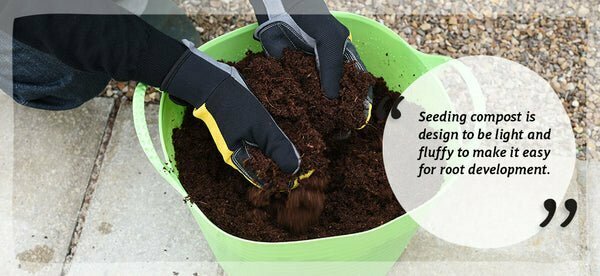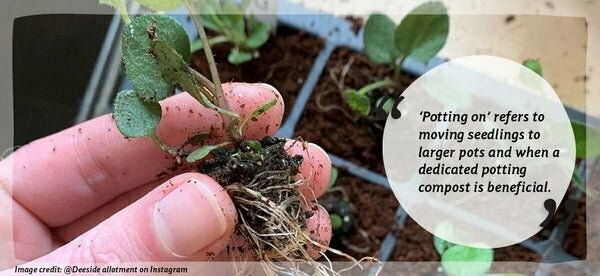What’s the difference between seeding compost and potting compost?
The huge choice of compost can be a little bamboozling. When it comes to seeding vs potting, what sets them apart from each other? Is there any real difference?
Can you use any compost for seed?
It’s tempting to just opt for a general supermarket’s multipurpose compost for your seeds and garden plants. But, you’ve guessed it, the labels on composts are important and do highlight the general differences. It isn’t just a marketing ploy to sell more. All plants have different needs at different points in their growing cycles. In particular, when they are seeding versus when they are maturing.
In the wine industry, a vineyard’s terroir refers to its climate and soil. Even the smallest changes can affect the grapes. The same goes for your own patio, balcony, windowsill or garden. Selecting the right compost for each stage of a plant’s development will put you streets ahead when it comes to your final harvest. A multipurpose compost is less, well, multipurpose than you might think if you want fantastic results.
The best start for your seedlings
Seeding compost is like sending your seeds to nursery school. They already have a ‘lunchbox’ of nutrients within the seed itself to get them going. As such, they don’t need any more nutrients until they have fully germinated and used up the nutrients in their seed. Adding nutrients at this point can actually damage the seeding process.
Your job is to give them a light, fluffy compost in which they can push down early fragile roots. Do this, and you’ll be rewarded with good germination rates and stronger plants.

If you’re planting them in seed trays, a peat free compost like our Coco Grow is perfect. For larger seeds, try our innovative individual Seed starter pellets to create your own professional plug plants at home. You can easily plant them out or pot on.
Pro tip: Thinning out
If you’ve sown the seeds too near together, you might need to ‘thin out’ the seedlings that pop up. This is when you transfer some of them to another seed tray. When lifting a seedling, the best way to gently tease it out is by holding it by a leaf, not the stalk.
Of course, you don’t have this problem if you sow using Coco Dots, which are made for individual seeds.
Potting primary school
The time you move your seedlings into larger pots is known as ‘potting on’. This gives them more room to stretch their roots.

A dedicated potting compost such as Coco Boost combines the right soil structure to support root growth. But also the stability to support overall plant growth.
The main difference between potting compost and seeding compost is the addition of nutrients. Now the seeds have germinated, they will have used up the nutrients within the seed. That’s when gardeners step in to give them a boost through potting them into the right type of compost.
Compost uses a mix of NPK chemicals, which all help plants to grow.

If you’ve only a hazy memory of your chemistry Periodic Table, here’s what they stand for:
- Nitrogen (N): helps with forming leaves, stems and branches
- Phosphorus (P): needed for root development – particularly important for vegetables like carrots and turnips
- Potassium (K): for flower, fruit and vegetable production.
What is a potting mix?
A potting mix combines potting compost with other ingredients to help specific plants. It’s all about nutritional balance. For example succulents like being dry, so you might want to add more perlite or sand. Ferns prefer to be damper. Creating your own potting mix? You can combine Coco Boost as part of your growing medium ‘cocktail’ as it’s sterile, so won’t contain fungal diseases.
What compost is used for transplanting seedlings?
When you transplant seedlings and ‘pot them on’, that’s when you transfer them to a potting compost.
Can I grow seeds in potting compost?
It’s possible, but not advisable. The chances are seeds won’t do well. A potting compost or ‘potting mix’ has added nutrients, which is too much for seeds. It may also contain green material, such as manure or recycled food.
The compost is also coarser, with larger lumps. This makes it much more difficult for seeds to take root.
Why is some compost not suitable for seeds?
Potting compost isn’t the best for seeds. And neither is a multipurpose compost.
Giving nutrients to seedlings often make them ‘leggy’ or ‘spindly’ where stems shoot up without the root support to be able to hold them. As such they can fall over and rot.
Fertilisers also contain nitrates and salt, which can suck out the moisture from plants leading to ‘fertiliser burn’. Larger plants have the surface area to cope with this but seedlings are too small. You might inadvertently be killing them with kindness due to an overload of nutrients.
Buying the right amount of compost
When you’re trying something new in gardening, it can be hard to judge how much compost you need. Also if you’ve only a balcony or patio, where can you store one huge bag of compost, let alone two?
Our organic coir compost is the answer. Just one 1kg coco brick can make up to 15 litres of compost! Just add water and fluff it up.
Rather than massive bags, our cardboard boxes and wrapped coir bricks can be easily tucked away.
Tips from the ‘Green Gardeners Guild’ online advice library
Need some more advice? Check our Q&A on Twitter and ask us your questions.
Want to ‘dig in’ to more detail? We’ve also loads more tips to help every plant parent:
- How to grow vegetables in coco coir peat
- Using coco peat to grow plants in pots
- How often should I give my plants nutrients?
Calling all seedling stars and ‘Potting’ heads!
Any experts with tips to share out there?
We’d love you to post your pictures and tag @cocoandcoir on Instagram. We’ll credit you for any images we use and you’ll also be in with a chance to win some Coco & Coir goodies for your sustainable garden.










